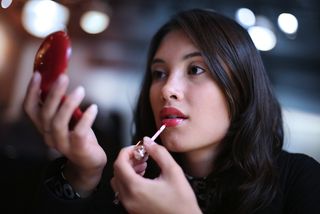Men Prefer Pink Female Genitals to Red, Study Finds

Red lips, red hearts, red negligees — there's no doubt that red is a seductive color. A common explanation for the sexiness of red suggests that men are attracted to the color because it reminds them of genital arousal, much as the red swellings on female baboons' bottoms signal receptivity to male baboons.
But this folk theory doesn't hold up to the harsh light of science, a new study finds. In fact, men are more attracted to pink genitals than red.
"It's too simplistic to basically say, 'Oh well, our closest primate relatives have these genital swellings and therefore men are reacting to red coloring,'" said study researcher Sarah Johns, anthropologist at the University of Kent. Instead, the appeal of red must lie elsewhere, Johns told LiveScience.
Seductive red
If red clothing or lipstick acts as a proxy for genitals, it stands to reason that men would prefer redder vulvas on women, Johns said. But no one had ever tested whether they actually do. So she and her colleagues decided to find out. [5 Myths About Women's Bodies]
The researchers first needed some similar, non-pornographic pictures of female genitals, a task that was "quite difficult," Johns said. Finally, they found a website set up so that women could anonymously submit photographs of their vulvas as part of a project meant to educate women on the diversity of genitals and improve self-esteem. The researchers picked four similarly angled photos and retouched each of them into pale pink, light pink, dark pink and red.
"We were really careful to make sure that the re-coloring looked natural," Johns said.
Sign up for the Live Science daily newsletter now
Get the world’s most fascinating discoveries delivered straight to your inbox.
Ranking red
The researchers then asked 40 heterosexual men to look at all 16 images in random order and rank them on a 0-to-100 scale of attractiveness. The results showed that instead of preferring red, the men actually showed the least preference for red vulvas.
"It basically showed that there was no different between the three pinkish shades, but the reddish shade was ranked significantly less attractive," Johns said. She and her colleagues published their research April 6 in the journal PLoS ONE.
The red used wasn't bright enough to mimic a sexually transmitted infection, Johns said, but it's possible the shade still brought to mind inflammation. Still, the fact remains that red has been shown to be an eye-catching, "dominant" shade, especially in competitive situations. Why remains an open question, Johns said.
"Certainly the effect of red is there, but taking this kind of sexual signal out of the equation means we actually can explore why this is the case," she said.
You can follow LiveScience senior writer Stephanie Pappas on Twitter @sipappas. Follow LiveScience for the latest in science news and discoveries on Twitter @livescience and on Facebook.

Stephanie Pappas is a contributing writer for Live Science, covering topics ranging from geoscience to archaeology to the human brain and behavior. She was previously a senior writer for Live Science but is now a freelancer based in Denver, Colorado, and regularly contributes to Scientific American and The Monitor, the monthly magazine of the American Psychological Association. Stephanie received a bachelor's degree in psychology from the University of South Carolina and a graduate certificate in science communication from the University of California, Santa Cruz.
Most Popular




